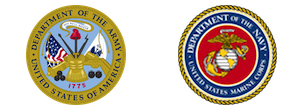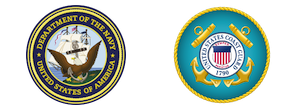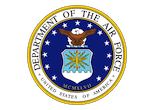U.S. Army and U.S. Marine Corps
The organizational units of these two services range in size from smaller to larger beginning with the individual serviceman. The first grouping is a fire team or section consisting of 5 or 6 people led by a corporal. Subsequent units are: the squad (sergeant, 9 or more people); platoon (lieutenant, about 40 people); company, troop, or battery (captain, 100-120 soldiers); battalion or squadron (lieutenant colonel, up to 600 or so); regiment or brigade (colonel or brigadier general, about 2000 members); division (major general, 12,000 to 15,000 people); corps (lieutenant general, 125,000 or more people); finally an army and/or army group (general, more than 250,000). Compare theses numbers to the population of the town in which you reside!
U.S. Navy and U.S. Coast Guard
The organization of these two services is based upon ships which vary by size and number of crew. Individual naval vessels may be commanded by any number of ranks, depending (again) on size, but usually by a lieutenant (the equivalent of an Army/Marine captain), a lieutenant commander or commander (major or lieutenant colonel equivalent) or captain (colonel equivalent). A rear admiral lower half (one-star) or upper half (two star); vice admiral (three star); or admiral (four star) commands various large naval formations.
The individual ship is the basic naval unit. A flotilla has at least two ships, and usually up to nine in size. If large such as nine ships, then the flotilla may be divided into divisions. If divided that way, a captain usually commands a flotilla and a commander a division. A squadron has at least two large capital ships (aircraft carriers or battleships); one aircraft carrier plus a battleship or heavy cruiser is an example. A captain commands a squadron. A naval task force has no set size or structure; it may also be international in its composition (such as US and British ships or NATO). Task forces are commanded by a Rear Admiral lower half, upper half, or a Vice Admiral. A fleet has no set size but is a “group” of flotillas and squadron commanded by an admiral.
The U.S. Air Force
The basic unit of this service is the individual airman. Two or more airmen can form a section. A flight has two or more airmen; two or more sections can also form a flight. A squadron has two or more flights. This is the lowest level of command with a headquarters element (example, a Squadron Commander, or Squadron First Sergeant). In the US Air Force, a squadron commander is generally in the rank of Lieutenant Colonel (O-5), although smaller squadrons may be commanded by majors, captains, and sometimes even lieutenants. A group is two or more squadrons. The group commander is usually a colonel (O-6). Two or more groups compose a wing. There is usually only one wing per Air Force base; the wing commander is quite often considered to be the “Installation Commander.” Wing commanders hold the rank equivalent to brigadier general in the Army.
Air Force “numbers” (e.g. 7th Air Force) are usually assigned to denote geographical locations or areas of operation (such as Europe or the Pacific). Such designations are primarily used during wartime. In peacetime, they generally consist of only a limited number of headquarters staff whose job is to prepare and maintain wartime plans. Lastly you have the major command or (MAJCOM) which is primarily organized by mission. Wings located in the Pacific Region (Hawaii, Japan, Korea, etc.) would usually be assigned to Pacific Air Force. Another example would be USAFE (United States Air Forces Europe), which control most wings assigned to Europe. MAJCOMS report directly to Air Force HQ in Washington, DC.




 Saving...
Saving...